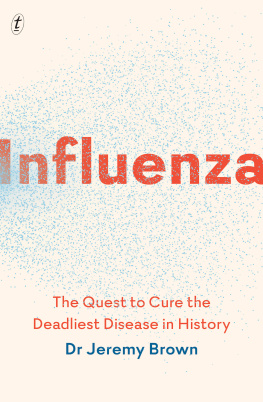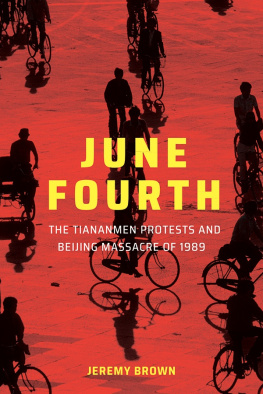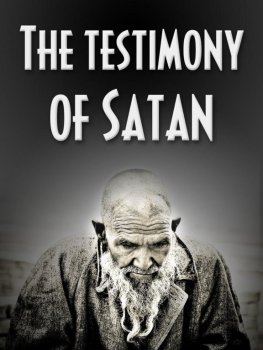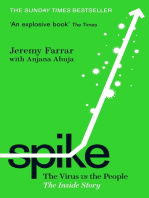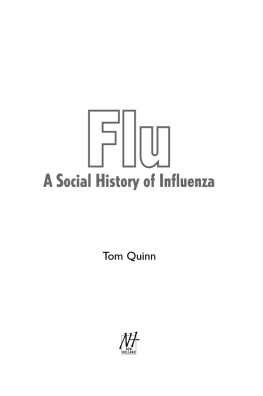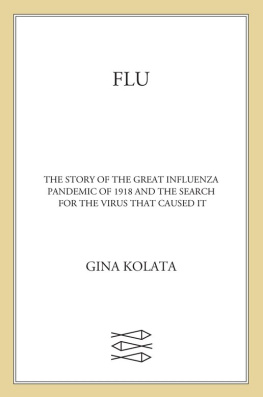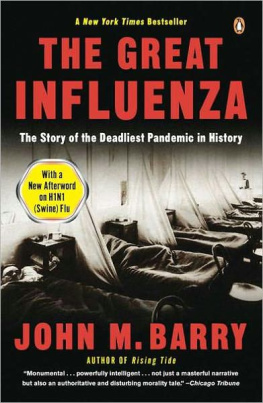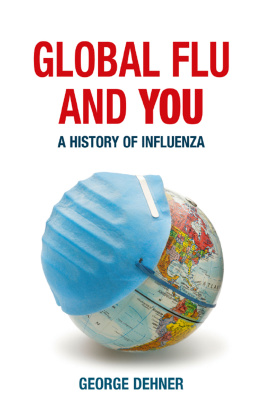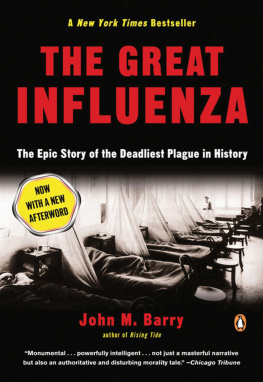
While influenza is now often thought of as a mild disease, it kills thousands of Australians each year. Dr Jeremy Brown, currently Director of Emergency Care Research at the National Institutes of Health, expounds on the flus deadly past to solve the mysteries that could protect us from the next outbreak.
In Influenza, he talks with leading epidemiologists, policy makers, and the researcher who first sequenced the genetic building blocks of the virus to offer both a comprehensive history and a roadmap for understanding whats to come.
Dr Brown digs into the discovery and resurrection of the flu virus in the victims of the 1918 epidemic exhumed from the tundra, as well as the bizarre remedies that once treated the disease, such as fatal doses of aspirin and blood-letting. Influenza also breaks down the current dialogue surrounding the disease, explaining the controversy over vaccinations, antiviral drugs such as Tamiflu, and the federal governments role in preparing for a pandemic. Dr Brown warns that many of the most vital questions about the flu virus continue to confound even the leading experts.
Influenza is an enlightening and unnerving look at a shapeshifting deadly virus that has been around since long before people and will most likely be with us for a long time to come.
Dedicated to the memory of the dead and the living:
Private Roscoe Vaughan of Buffalo, New York, who died of influenza at Camp Jackson, South Carolina, on September 26, 1918. His death helped us better understand the virus that killed him and millions of others.
Autumn Reddinger, whose fight against influenza is a lesson in personal courage and the triumphs of modern medicine.
To prevent the spread of Spanish Influenza, sneeze, cough or expectorate into your handkerchief. You are in no danger if everyone heeds this warning.
SIGNS POSTED IN PHILADELPHIA RAILCARS, OCTOBER 1918
Theres nothing quite like flu in terms of the risk.
TOM FRIEDEN, FORMER DIRECTOR OF THE CENTERS FOR DISEASE CONTROL AND PREVENTION, JANUARY 2017
CONTENTS
Autumn Reddinger was deathly sick. Her lungs were not working. Her heart was so weak that it could no longer pump blood through her body. The only thing keeping her alive was a heart-lung machine. She lay corpse-like in the intensive care unit. Her parents had called their pastor to administer last rites. How would they tell Autumns young children that their mom, who was raising them alone, was dying from influenza, an illness that was usually shrugged off as a minor inconvenience? That a vibrant young woman who went to the gym twice a week was now, in December 2013, at deaths door?
During the Christmas break, Autumn thought she had a cold but soldiered through the holiday with her parents and two young children at her home in western Pennsylvania. Two days later she felt much better and went to dinner with a friend, Joe. When she returned to her house she began texting him, but the messages he received were jumbled and made no sense. She had been totally coherent at dinner, and Joe knew she hadnt had any alcohol. Alarmed, he got in his car and drove to Autumns home, where he found her confused and weak. He called her parents to watch the kids and drove her to the local hospital in Punxsutawney. She told the emergency room nurses that her lungs were on fire.
The ER physician went through every test: Autumns lungs sounded clear when he listened to them with a stethoscope. Her pulse and blood pressure were perfect. She had no fever. Her chest X-ray showed no infection in her lungs. Her blood tests were normal, and a rapid test for influenza came back negative. But something wasnt right, so he admitted Autumn to the hospital for observation, just to be safe, and started her on antibiotics.
Autumns condition quickly worsened. Over the next few hours she became increasingly disoriented and found it harder and harder to breathe. The antibiotics didnt seem to make a difference. The staff made a call to Mercy hospital in Pittsburgh, a two-hour drive away. Autumns condition was now critical. Transferring her by ambulance was too risky. Mercy sent a medevac helicopter. By the time it arrived, Autumn could no longer breathe on her own. She was sedated, a tube was put into her throat, and she was connected to a ventilator.
Autumn was taken directly to the intensive care unit at Mercy. By now she was coughing up blood, and it became almost impossible to get enough oxygen into her to keep her alive. A chest X-ray showed that her lungswhich had sounded clear and looked entirely normal a few hours earlierwere now filled with pus and fluid. She was given more antibiotics and hooked up to IV medications to keep her blood pressure from dropping. At one a.m. the ICU team called in Dr. Holt Murray, who had trained as an emergency physician and now specialized in critical care. He was Autumns last hope.
Murray was an ECMO specialist. ECMO, or extracorporeal membrane oxygenation, is the medical term for the technique used by a heart-lung machine. It takes dusky and dark blood, scrubs it of carbon dioxide, fills it with oxygen, and sends it back, red and healthy, into the body. Doctors use it when they perform heart or lung transplants. Since Autumns lungs were not functioning at all, the machine could step in and do their work.
When Murray talks to family members about putting a patient on ECMO, he has very little timeperhaps only a few minutesto explain the procedure and get their permission. I dont think we have other options, he will say, though he is careful to be cautious. ECMO is potentially lifesaving, but it comes with a host of complications.
Families are usually in no state to make an informed decision, and are highly dependent on the doctor to guide them. Autumns parents, who had arrived at Mercy, agreed with the ECMO plan.
Very quickly Murray inserted a big needle into a vein in Autumns groin. This would remove her blood and send it to the machine to be scrubbed and filled with oxygen. Another needle went into her neck, where the blood would return. It didnt take long for the ECMO machine to improve her oxygen levels. But then her heart stopped.
Murray and his team of nurses and specialists began continuous chest massage and gave an injection of epinephrine to restart the heart. Brief success. Then another episode. More epinephrine. The heart kicked back into action, but it was barely working. Murray did an ultrasound of Autumns heart that showed it was functioning at less than 10 percent of capacity. It was no longer able to pump blood through her body.
Doctors have a rather unsavory term for patients in Autumns condition: circling the drain. It describes, in cold and colloquial terms, that hopeless feeling when every attempt to save a patient is failing. Autumn was circling the drain.
Even though the initial influenza test had been negative, Murray now repeated it using a much more sensitive technique. It revealed that Autumn had the H1N1 influenza virus, the same virus behind the swine flu outbreak of 2009. In a matter of hours, the virus had destroyed her lungs and was now attacking her heart muscle. The ECMO machine that had taken over for her lungs was no longer good enough. It now needed to take over the work of her failing heart. To do that, the machine needed to be replumbed. And that meant transferring Autumn four blocks to the University of Pittsburghs Presbyterian hospital, where a cardiothoracic surgeon could do the procedure. Murray traveled with her in the back of an ambulance, carefully monitoring the portable ECMO machine. Autumn was taken directly to the operating room. The surgeon cracked open her sternum with a surgical saw, and then inserted one catheter into her right atrium, one of the four chambers of her heart. A second catheter went directly into her aorta, and her sternum was wired back together. Her chest now had a long, fresh vertical wound and two large tubes sticking out from it, connecting Autumn to the heart-lung machine. This was the end of the road. There were no more machines, no better interventions or heroic measures that Murray could offer. She would either pull through or die.
Next page
